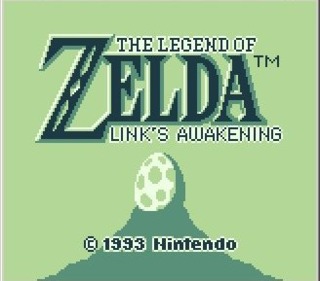Overview
The Legend of Zelda: Link's Awakening was the first Zelda game released on a handheld. Produced by Shigeru Miyamoto and directed by Takashi Tezuka, Link's Awakening was released in Japan in June 1993 and in North America two months later. Link's Awakening garnered positive reviews and set the way for future handheld versions for the series. A DX version was released for the Game Boy Color in 1998.
Story
 Title Screen
Title ScreenAt the start of Link's Awakening, Link is washed ashore Koholint Island after a storm at sea. He is rescued by Marin and her father, Tarin, and is brought back to Mabe Village. Soon after, Link is visited by an owl who gives him the quest of gathering the eight instruments of the Sirens and awakening the Wind Fish who is sleeping inside of a giant egg in the mountains. Link, the ever silent protagonist, continues on to visit a mountain range, a forest, plains, a castle, a swamp, the beach, the desert, and many dungeons to complete his task. Link's Awakening is unusual in the Legend of Zelda universe in that it does not involve Hyrule, Ganon, or the Triforce at all. Princess Zelda only receives a single passing mention.
Gameplay
Link's Awakening is a traditional top-down Legend of Zelda title. Link traverses the overworld of Koholint Island venturing into eight dungeons, gathering an item within each that is then often used to defeat the dungeon boss. After the boss has been defeated, Link acquires an Instrument of the Sirens. In between dungeons, minor tasks are preformed to help collect a key to the next dungeon.
Link's Awakening introduced many significant elements that have become mainstays of the Zelda series. It was the first game in the series which required the player to press a button to raise their shield. It also allowed players to equip two items, neither of which had to be the sword or shield, creating puzzles where the player had to combine the abilities of two items, e.g. using the Roc's Feather while sprinting with the Pegasus Boots to jump further. It also introduced the series first trading sequence, fishing side quest and set of well hidden collectable items that can be redeemed at a specific location for rewards. It was the first game to give each dungeon its own specific background theme instead of a single generic dungeon theme. It was the first appearance of an ocarina in the Zelda series (the GBA version of A Link to the Past would later rename the flute to ocarina). Although not the first time a musical instrument was featured in a Zelda game, it was the first time multiple songs could be played on said instrument.
There are many references to the Mario series in the game. In the side-scrolling levels Goombas and Piranha Plants can be found and in the main village there is a Chain Chomp. The trading quest begins with a Yoshi doll and one of the items that makes up the the long chain of trades is a picture of Princess Peach. Tarin and the Cucco Keeper resemble Mario & Luigi respectively, Mamu resembles Wart while Mr. Write resembles Dr. Wright from the SNES version of SimCity and Richard is from For the Frog the Bell Tolls (hence the frogs in his villa). Tarin's transformation into a raccoon could also be a reference to the tanooki suit from Super Mario Bros 3.There are also many enemies that can be found in dungeons and the overworld that are from Mario games.
Dungeons
Items
Additional Information
- Director Takashi Tezuka has said that the unusual and often self-aware nature of Link's Awakening was directly inspired by the television show Twin Peaks.
- One of the puzzles in the second dungeon involves a clue on the wall, describing the order in which to kill the rooms enemies. Unfortunately the names that were given are of no use, because the western version manual makes no mention as to the names of monsters/enemies, compared to the Japanese version.
- It is possible to steal an item from the shop by picking it up and carrying outside when the shopkeeper isn't looking. However, if the player does this, the player character's name is changed to "THIEF" for the rest of the game. If the player returns to the shop afterwards, the shopkeeper will kill the player.
- If the player waits for two minutes and thirty seconds in Richard's Villa, the music will change to Totaka's Song.
- If the player inputs "ZELDA" as the save file name, a remixed theme will play in the background of the save select screen.
- Unlike the other Zelda games, none of the levels are referred to as dungeons or temples.
- The maximum number of hearts is 14 instead of the usual 20.
- The layout of all of the dungeon maps, except Eagle's Tower, form a picture of an object, such as a bottle for Bottle Grotto or a key in Key Cavern.
Log in to comment